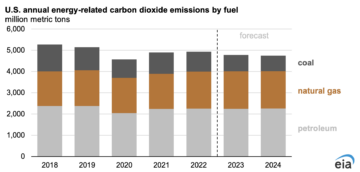Sign up for daily news updates from CleanTechnica on email. Or follow us on Google News!
The solar energy world is ready for a revolution. Scientists are racing to develop a new type of solar cell using materials that can convert electricity more efficiently than today’s panels.
In a new paper published February 26 in the journal Nature Energy, a CU Boulder researcher and his international collaborators unveiled an innovative method to manufacture the new solar cells, known as perovskite cells, an achievement critical for the commercialization of what many consider the next generation of solar technology.
Today, nearly all solar panels are made from silicon, which boast an efficiency of 22%. This means silicon panels can only convert about one-fifth of the sun’s energy into electricity, because the material absorbs only a limited proportion of sunlight’s wavelengths. Producing silicon is also expensive and energy intensive.
Enter perovskite. The synthetic semiconducting material has the potential to convert substantially more solar power than silicon at a lower production cost.
“Perovskites might be a game changer,” said Michael McGehee, a professor in the Department of Chemical and Biological Engineering and fellow with CU Boulder’s Renewable & Sustainable Energy Institute.
Scientists have been testing perovskite solar cells by stacking them on top of traditional silicon cells to make tandem cells. Layering the two materials, each absorbing a different part of the sun’s spectrum, can potentially increase the panels’ efficiency by over 50%.
“We’re still seeing rapid electrification, with more cars running off electricity. We’re hoping to retire more coal plants and eventually get rid of natural gas plants,” said McGehee. “If you believe that we’re going to have a fully renewable future, then you’re planning for the wind and solar markets to expand by at least five to ten-fold from where it is today.”
To get there, he said, the industry must improve the efficiency of solar cells.
But a major challenge in making them from perovskite at a commercial scale is the process of coating the semiconductor onto the glass plates which are the building blocks of panels. Currently, the coating process has to take place in a small box filled with non-reactive gas, such as nitrogen, to prevent the perovskites from reacting with oxygen, which decreases their performance.
“This is fine at the research stage. But when you start coating large pieces of glass, it gets harder and harder to do this in a nitrogen filled box,” McGehee said.
McGehee and his collaborators set off to find a way to prevent that damaging reaction with the air. They found that adding dimethylammonium formate, or DMAFo, to the perovskite solution before coating could prevent the materials from oxidizing. This discovery enables coating to take place outside the small box, in ambient air. Experiments showed that perovskite cells made with the DMAFo additive can achieve an efficiency of nearly 25% on their own, comparable to the current efficiency record for perovskite cells of 26%.
The additive also improved the cells’ stability.
Commercial silicon panels can typically maintain at least 80% of their performance after 25 years, losing about 1% of efficiency per year. Perovskite cells, however, are more reactive and degrade faster in the air. The new study showed that the perovskite cell made with DMAFo retained 90% of its efficiency after the researchers exposed them to LED light that mimicked sunlight for 700 hours. In contrast, cells made in the air without DMAFo degraded quickly after only 300 hours.
While this is a very encouraging result, there are 8,000 hours in one year, he noted. So longer tests are needed to determine how these cells hold up overtime.
“It’s too early to say that they are as stable as silicon panels, but we’re on a good trajectory toward that,” McGehee said.
The study brings perovskite solar cells one step closer to commercialization. At the same time, McGehee’s team is actively developing tandem cells with a real-world efficiency of over 30% that have the same operational lifetime as silicon panels.
McGehee leads a U.S. academic–industry partnership called Tandems for Efficient and Advanced Modules using Ultrastable Perovskites (TEAMUP). Together with researchers from three other universities, two companies and a national laboratory, the consortium received $9 million funding from the U.S. Department of Energy last year to develop stable tandem perovskites that can feasibly be used in the real world and are commercially viable. The goal is to create tandem more efficient than conventional silicon panels and equally stable over a 25-year period.
With higher efficiency and potentially lower price tags, these tandem cells could have broader applications than existing silicon panels, including potential installation on the roofs of electric vehicles. They could add 15 to 25 miles of range per day to a car left out in the sun, enough to cover many people’s daily commutes. Drones and sailboats could also be powered by such panels.
After a decade of research in perovskites, engineers have built perovskite cells that are as efficient as silicon cells, which were invented 70 years ago, McGehee said. “We are taking perovskites to the finish line. If tandems work out well, they certainly have the potential to dominate the market and become the next generation of solar cells,” he said.
Courtesy of & University of Colorado.
Have a tip for CleanTechnica? Want to advertise? Want to suggest a guest for our CleanTech Talk podcast? Contact us here.
Latest CleanTechnica TV Video
[embedded content]
Advertisement
CleanTechnica uses affiliate links. See our policy here.
- SEO Powered Content & PR Distribution. Get Amplified Today.
- PlatoData.Network Vertical Generative Ai. Empower Yourself. Access Here.
- PlatoAiStream. Web3 Intelligence. Knowledge Amplified. Access Here.
- PlatoESG. Carbon, CleanTech, Energy, Environment, Solar, Waste Management. Access Here.
- PlatoHealth. Biotech and Clinical Trials Intelligence. Access Here.
- Source: https://cleantechnica.com/2024/03/23/researchers-take-major-step-toward-developing-next-generation-solar-cells/
- :has
- :is
- :where
- $9 million
- $UP
- 000
- 15%
- 25
- 26
- 300
- 400
- 70
- 700
- 8
- a
- About
- absorbs
- Achieve
- achievement
- actively
- add
- adding
- additive
- advanced
- Advertise
- Affiliate
- After
- ago
- AIR
- All
- also
- Ambient
- an
- and
- applications
- ARE
- AS
- At
- BE
- because
- become
- been
- before
- believe
- Blocks
- Box
- Brings
- broader
- Building
- built
- but
- by
- called
- CAN
- car
- cars
- cell
- Cells
- certainly
- challenge
- Changer
- chemical
- cleantech
- Cleantech Talk
- closer
- Coal
- collaborators
- Colorado
- commercial
- commercialization
- commercially
- Companies
- comparable
- Consider
- consortium
- content
- contrast
- conventional
- convert
- Cost
- could
- cover
- create
- critical
- Current
- Currently
- daily
- damaging
- day
- decade
- decreases
- Department
- Department of Energy
- Determine
- develop
- developing
- different
- discovery
- do
- dominate
- Drones
- each
- Early
- efficiency
- efficient
- efficiently
- Electric
- electric vehicles
- electricity
- electrification
- embedded
- enables
- encouraging
- energy
- energy intensive
- Engineering
- Engineers
- enough
- equally
- Ether (ETH)
- eventually
- existing
- Expand
- expensive
- experiments
- exposed
- faster
- February
- fellow
- filled
- Find
- fine
- finish
- five
- For
- found
- from
- fully
- funding
- future
- game
- game-changer
- GAS
- generation
- get
- gets
- glass
- goal
- going
- good
- Guest
- harder
- Have
- he
- higher
- his
- hold
- hoping
- HOURS
- How
- However
- HTTPS
- if
- improve
- improved
- in
- Including
- Increase
- industry
- innovative
- installation
- Institute
- intensive
- International
- into
- Invented
- IT
- ITS
- journal
- known
- laboratory
- large
- Last
- Last Year
- layering
- Leads
- least
- Led
- left
- lifetime
- light
- Limited
- Line
- links
- longer
- losing
- lower
- made
- maintain
- major
- make
- Making
- many
- Market
- Markets
- material
- materials
- max-width
- means
- method
- Michael
- might
- million
- Modules
- more
- more efficient
- must
- National
- Natural
- Natural Gas
- Nature
- nearly
- needed
- New
- news
- next
- next-generation
- noted
- of
- off
- on
- ONE
- only
- onto
- operational
- or
- Other
- our
- out
- outside
- over
- own
- Oxygen
- panels
- part
- Partnership
- people’s
- per
- performance
- period
- pieces
- Place
- planning
- plants
- plato
- Plato Data Intelligence
- PlatoData
- player
- podcast
- policy
- potential
- potentially
- power
- powered
- prevent
- price
- process
- producing
- Production
- Professor
- proportion
- published
- quickly
- racing
- range
- rapid
- reacting
- reaction
- ready
- real
- real world
- received
- record
- Renewable
- research
- researcher
- researchers
- result
- Revolution
- Rid
- running
- s
- Said
- same
- say
- Scale
- scientists
- see
- seeing
- semiconductor
- set
- showed
- Silicon
- small
- So
- solar
- Solar cells
- solar energy
- solar panels
- Solar Power
- solution
- Spectrum
- Stability
- stable
- stacking
- Stage
- start
- Step
- Still
- Study
- substantially
- such
- suggest
- Sun
- sunlight
- sustainable
- Sustainable Energy
- synthetic
- Take
- taking
- Talk
- Tandem
- team
- Technology
- Testing
- tests
- than
- that
- The
- their
- Them
- then
- There.
- These
- they
- this
- three
- time
- tip
- to
- today
- today’s
- together
- too
- top
- toward
- traditional
- trajectory
- tv
- two
- type
- typically
- u.s.
- Universities
- unveiled
- Updates
- us
- used
- uses
- using
- Vehicles
- very
- viable
- Video
- want
- wavelengths
- Way..
- WELL
- were
- What
- when
- which
- wind
- with
- without
- Work
- work out
- world
- year
- years
- you
- youtube
- zephyrnet






